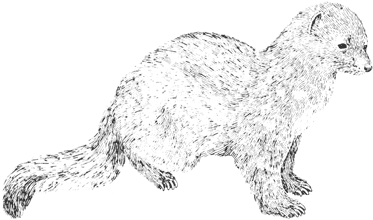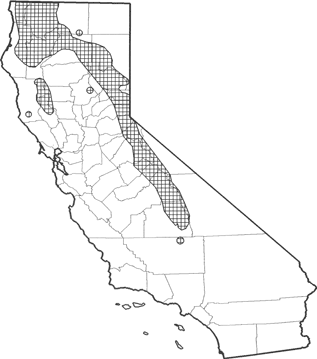
Fisher
Distribution, Abundance, and Seasonality
Uncommon permanent resident of the Sierra Nevada, Cascades, and Klamath Mts.; also found in a few areas in the North Coast Ranges (Grinnell et al. 1937). Occurs in intermediate to large-tree stages of coniferous forests and deciduous-riparian habitats with a high percent canopy closure (Schempf and White 1977).

Range Map
Specific Habitat Requirements
Feeding: Fishers are largely carnivorous. Eat rabbits and hares, especially snowshoe hares, and rodents (mice, porcupines, squirrels, mountain beavers), shrews, birds, fruits, and carrion. Prey on ground surface and in trees. Fishers are opportunistic; they search for small mammals, and pounce on, or chase prey. Also dig out prey. Grenfell (1979) reported that the most important food item in the stomachs of 8 fishers was false truffle, a subterranean fungus.
Cover: Fishers use cavities in large trees, snags, logs, rock areas, or shelters provided by slash or brush piles. Dense, mature stands of trees also provide cover, especially in winter.
Reproduction: Fishers den in a variety of protected cavities, brush piles, logs, or under an upturned tree. Hollow logs, trees, and snags are especially important.
Water: May require drinking water.
Pattern: Suitable habitat for fishers consists of large areas of mature, dense forest stands with snags and greater than 50% canopy closure.
Species Life History
Activity Patterns: Active yearlong. Mostly nocturnal and crepuscular, some diurnal activity.
Seasonal Movements / Migration: Non-migratory.
Home Range: In Ontario, Canada, home ranges were estimated at 38 km? (10 mi?) (deVos 1952). In Massachusetts, home ranges averaged 19.2 km? (74 mi?), and varied from 6.6 to 39.6 km? (2.5 to 15.3 mi?). Home ranges usually smaller in summer than in winter (Kelly 1977). The long axis of home range tends to parallel valleys. Home ranges of 3 adult males in Trinity Co. averaged 14 km? (5.4 mi?) (Buck et al. 1979). The fishers in Trinity Co. appeared to have regularly used travel routes within the home ranges (Buck et al. 1979)
Territory: Fishers appear to be territorial (Powell 1981b).
Reproduction: Females breed a few days after parturition; implantation of the embryo is delayed until the following winter. Post-implantation active growth lasts about 30 days (Powell 1981b). Young born February through May. Litter size averages 2.7, and ranges from 1-4, rarely 5. Young remain with female until late autumn. Males and females become sexually mature in the first or second yr (Powell 1982).
Niche: Few animals prey on fishers other than humans. Fishers are one of the few specialized predators on porcupines. Have been transplanted into Oregon, West Virginia, and other states for porcupine control (Hooven 1971, Powell 1981a, 1981b, 1982). Long-term studies suggest that fishers predominantly are terrestrial (Powell 1981b).
Sources & References
California Department of Fish and Game, 1999.
California's Wildlife, Sacramento, CA.
Written by: G. Ahlborn, reviewed by: M. White, edited by: M. White, G. Ahlborn
Buck, S., C. Mullis, and A. Mossman. 1979. A radiotelemetry study of fishers in northwestern California. Cal-Neva Widl. 1979:166-172. Clem, M. K. 1975. Interspecific relationship of fishers and martens in Ontario during winter. Pages 165-182 in R. L. Phillips and C. Jonkel, eds. Procs. 1975 Predator Symposium. Montana For. and Conserv. Exp. Sta., Missoula. 268pp. Coulter, M. W. 1966. Ecology and management of fishers in Maine. Ph.D. Diss. New York State Univ., Coll. For. Syracuse. 183pp. deVos, A. 1952. The ecology and management of fisher and marten in Ontario. Ont. Dep. Lands and Forests. Tech. Bull., Wildl. Ser. 1. 90pp. Grenfell, W. E., Jr. 1979. Winter food habits of fishers, Martes pennanti, in northwestern California. Calif. Fish and Game 65:186-189. Grinnell, J., J. S. Dixon, and J. M. Linsdale. 1937. Fur-bearing mammals of California. 2 Vols. Univ. California Press, Berkeley. 777pp. Hooven, E. F. 1971. The porcupine in Oregon: its life history and control. Oregon State Univ., Sch. For., Corvallis. Res. Pap. No. 10. 22pp. Kelly, G. M. 1977. Fisher (Martes pennanti) biology in the White Mountain National Forest and adjacent areas. Ph.D. Diss., Univ. Massachusetts, Amherst. 178pp. Powell, R. A. 1973. A model for raptor predation on weasels. J. Mammal. 54:259-263. Powell, R. A. 1981a. Hunting behavior and food requirements of the fisher (Martes pennenti). Pages 883-917 in J. A. Chapman and D. Pursley, eds. Worldwide furbearer conf. proc. 3 vols. 2056pp. Powell, R. A. 1981b. Martes pennanti. Mammal. Species No. 156. 6pp. Powell, R. A. 1982. The fisher. Univ. Minnesota Press, Minneapolis. 219pp Schempf, P. F., and M. White. 1974. A survey of the status of seven species of carnivores on National Park Service lands in California. Dep. For. And Conserv., Univ. Calif., Berkeley. 129pp. Schempf, P. F., and M. White. 1977. Status of six furbearer populations in the mountains of northern California. U.S. Dep. Agric., For. Serv., San Francisco, Calif. 51pp. Williams, D. F. 1986. Mammalian species of special concern in California. Calif. Dept. Fish and Game, Sacramento. Admin. Rep. 86-1. 112pp.
California Animal Facts | California's Wildlife